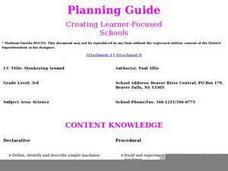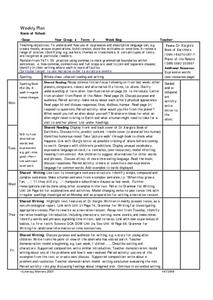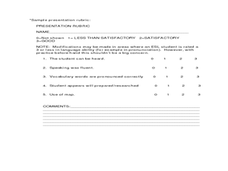Indiana University Libraries
Web Page Evaluation
Invite your learners to research three different websites that pertain to a topic focused on in your syllabus. Students fill out a chart by answering questions about each site. Then, they compare how useful the sites are to one another....
Ontario
Weekly Lesson Plan for Shared Reading
Reading is fun! Here, practice making predictions and instill concepts of print including the front of the book's features, the text's message, the connection between text and illustrations, and directionality with these daily reading...
Curated OER
Modernism in Poetry, Painting, and Music
Are you teaching Modernism to your class? Connect different areas of artistic expression in the Modernist Era. Learners read T.S. Eliot, view art by Pablo Picasso, and listen to a Modernist musical composition. This final assignment is...
Curated OER
Texas Kid Writes Book About Presidents
Arranged into small groups, learners read a paragraph of the news story "Texas Kid Writes Book About Presidents." As one reads, others mark the text (underlining important information and writing notes in the margin of the story). After...
Curated OER
Understanding Genres
Young scholars identify genres of literature. In this literature instructional activity, young scholars read definitions of the various genres. Young scholars choose books and list clues in the texts that help them identify the...
Curated OER
PERCEIVINGT A CULTURE THROUGH ITS LITERATURE
Studentsexamine cultural values in literature, identify the cultural assumptions, prejudices, and purposes of authors and translators, use historical perspective to determine if the values and lifestyle depicted apply to contemporary...
Curated OER
Language Arts: Stylistic Devices
Students are able to define given literary terms, such as metaphor, simile, imagery, personification, symbolism, etc. They are able to identify the use of literary elements in a given text. Students are able to interpret weather...
Curated OER
Satire in Fiction
Twelfth graders identify satire in various fictional texts. For this language arts lesson, 12th graders will learn to define satire, parody, and caricature. Students will identify different forms of satire in historical and modern-day...
Curated OER
Monkeying Around
Third graders study machines. They watch a video about and identify and chart machines they find at home and at school. They design and build simple and compound machines, create an advertisement for them and attempt to sell them at the...
Curated OER
Making Connections: I Know Why Caged Birds Sing
Students discuss equality and fairness by reading a Maya Angelo poem. In this U.S. history lesson, students read the poem I Know Why Caged Birds Sing, and discuss how the era it was written in affected the words. Students identify the...
Curated OER
Text Elements—Vampires
Students explore the tone and style of passages from horror genre literature. In this literary elements lesson, students read The Vampire by John Stagg and the War of the World script by H.G. Wells, Students write about the way the...
Curated OER
Substance Use, or Abuse?
Young scholars identify the medicinal benefits, and ill effects, of a variety of controlled substances. They determine whether or not they think hallucinogens should be researched for possible medicinal purposes.
Curated OER
Understanding Persuasive Writing
High schoolers give examples of how the media glamorize violence and desensitize viewers to the horrors of real acts of violence. They identify factors in addition to the media that contribute to the problem of violence in society.
Curated OER
Lead Critical Reading
Students read opposing views on the lead contamination issue, identify the facts and opinions in each article, and infer the opinion of the author. They create an essay expressing their opinion on the issue complete with citations.
Curated OER
THE TRAVELS OF BABAR: An Adventure in Scales
Young scholars locate and identify the seven continents. They use longitude and latitude in establishing a location. Students enhance the knowledge of geographical location with cultures. Individuals or small groups research multiple...
Curated OER
1920s Images and Ideals PowerPoint Project
Learners explore Teaching the American Twenties, noting fashion, life styles, Hollywood, key authors, key people, and key events. They explore the sites and note what they can identify from the time period for this collection. They write...
Curated OER
Did Jack break the law?:
Learners identify the process for settling a legal dispute, identify key players in a legal dispute (who presents the facts; who makes the final decision) and determine what makes a decision fair.
Curated OER
That's MY Pencil: Simplified Mock Trial
Learners identify the process for settling a legal dispute, identify key players in a legal dispute (who presents the facts; who makes the final decision), and determine what makes a decision fair.
Curated OER
Life Processes
Students identify life processes and create their own creature. In this creative science lesson, students identify an organism's life processes and categorize them into groups. They then create their own creature and write about how it...
Curated OER
Movement
Students explore experimentation as a method for solving problems. In this movement lesson plan, students observe marbles rolling down a ramp, identify variables that could cause the marble to roll faster or farther, test changing one...
Curated OER
Something from Nothing
Students identify opportunity costs. In this resources lesson plan students are read the story Something from Nothing by Phoebe Gilman. Students list the things Grandpa makes Joseph. Students state why people make choices.
Curated OER
"Dr. Xargle's Book of Earthlets"
Students examine the expressive and descriptive language used in the books "Dr. Xargle's Book of Earthlets" and "Planet of the Robots." In pairs they take notes about each other's physical appearance and conduct interviews, identify the...
Curated OER
Places in My World
Second graders explore where they are located on the globe. In this maps and globes lesson, 2nd graders use a map to show where they live and show the cardinal directions. Students identify characteristics of mountains, flat land,...
Smithsonian Institution
For Land's Sake: George Washington as Land Surveyor
Students discuss the importance of land ownership and the purpose of land surveying in the eighteenth century. They interpret a transcript of an eighteenth-century land survey. They survey and area of land. They create a written or...
























